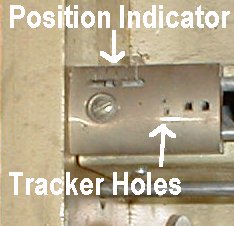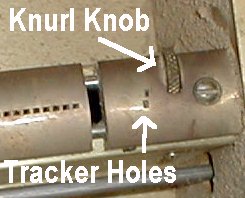
|

|

|

|

|

|
| Home | Manuals | Supplies | Search | Consult | Contact | Testing | Service |
|
Theory of Operation
Occasionally, I receive letters like the one just below:
Hi, John,
I got the piano off life support (shop vac), and also got the tempo control adjusted, and I'm really enjoying getting involved with the many adjustments needed. It's a tad harder to pump now, but that was expected. I'm having a bit of a problem with the Tracking Device. I went completely through it and inspected every part of it. It's connected to the tracker bar via lead tubes with elbows shellacked into the tracker body. I found that when it's in operation, it responds to the system by staying hard down. No amount of covering the tracker bar holes has any effect on its position.
I didn't replace any of the gaskets when I had it apart. I had to recloth the side, which I wasn't sure of because there are no instructions in A.Reblitz book on that part of the repair. I glued the entire side and placed the cloth to cover the entire side of the control. Hope that was right The old one was split at the joint. There are two drilled passages in the face of the control, but they're covered by the cloth. Don't understand that set up at all. Maybe it's supposed to be a hinge when the control is split
One of the pouches looks bad, another looks like it might have a hole, but I'm not sure. Please send me enough pouch material to do at least 4 pouches. What do you think about replacing all gaskets in the control with 1/16" cork? I found some real nice tight grained cork at a hardware store in town. Another question is, Are the primary valves and inside valves supposed to be set as close as those in the action? There's no mention in the book.
Well, sorry for the longwinded note, but at least I didn't call you with this.
Regards, Fred
Hi Fred,
Tracking mechanisms can be tricky...... It sounds to me
like there is a leak in a signal line leading to a pouch. Or,
a pouch isn't dished deep enough, which prevents the
valve from seating. You might also have a leaky valve.
Obviously, if there are any leaks in the pouches or valves,
the mechanism cannot work correctly.... It is imperative
that the valve block and bellows be 100% air-tight. The
slightest leak will cause the device to malfunction.
I've repaired numerous tracking devices without replacing
the gaskets. However, they are always replaced when the
device gets rebuilt.
I will assume that you checked the bleeds and that they
are clean. I will also assume that you checked the air-tightness
of both bellows before attaching them to the valve block.
Also, you can check the operation of the valve block before
you put the bellows back on. The process is a little difficult to
put into words. You have to understand how the block works.
Basically, you open and close the signal ports leading to the
valves as would happen when the paper opens and closes the
ports, and you see how the device responds. (See page 27 of
the Service Manual for proper valve clearance and cleaning.)
One of the reasons I haven't attempted to create a webpage
about testing, repairing, and rebuilding a tracker mechanism is that for
starters there are four basic types. Those four basic types are
then sub-divided into various smaller groups that have slight
design differences. Explaining how each one operates and how
to rebuild and test them would likely fill a small book.
If it's of any help, the four-hole tracker device is something like
two and-or circuits in transistor theory. When the two inside holes
are closed, the two outside holes control the bellows. When both
outside holes are open, the two inside holes control the bellows.
In other words, opening the two outside holes changes the state
of the associated valves and turns control of the bellows over to
the other two valves. You can watch this happen. When all four
holes are closed, both primary (or outside) valves are closed,
and vacuum is applied equally to both bellows, keeping them
centered. As one outside hole on the trackerbar opens (right or
left), this opens (or activates) the associated valve and it changes
state. This turns OFF the vacuum to one bellows, causing the
other to draw further IN (or collapse), which adjusts the position
of the music roll. In the condition when both outside holes are
open, both primary valves are activated (or UP), and an equal amount
of vacuum is applied to both bellows via the secondary valves.
As one of them gets activated, by opening a hole on the trackerbar,
it TURNS OFF the associated Primary Valve, which in turn shuts
off the vacuum to the associated bellows and allows the other bellows
to collapse, adjusting the position of the roll.
It goes without saying that the four-hole tracking device is the
most complex device in any regular 88-note player piano. Getting
a grasp of the theory of operation is somewhat difficult since it is
kind of backwards compared to other pneumatic devices, i.e., when
it's Off, it applies vacuum to the bellows.
Hope this helps.... I'll send you a piece of leather for the pouches.
The cork gasket material should work well as long as it compresses
slightly. If it won't compress, then it might leak a tiny amount, which
will cause a problem. The gasket must compress to handle any
slight irregularities in the wood. BTW, the cloth cover is basically there
to create an air-tight seal over that part of the block. However, if it is
glued on with hide glue, it can be relatively easily removed to access the air
channels for cleaning. Occasionally, a bleed will get very clogged such that
the trackerbar pump can't clear the bleed. In such cases, the cloth can be removed
and the bleed cleaned manually.
Musically,
John A. Tuttle


For more information about roll tracking problems and solutions, see:
Tracking Problems - Click Here |

![]() ..To
The Top of this Page . . . . . . . . . . .
..To
The Top of this Page . . . . . . . . . . . ![]() ..To The HOME Page
..To The HOME Page
|
Since "Player-Care" is an internet business, I prefer that we correspond via E-Mail (click here to fill out the 'Request Form'). However, if I'm not in the middle of some other activity, you can reach me at 732-840-8787. But please understand that during the hours from 8AM-5PM EST (Mon-Sat), I'm generally quite busy. So, I probably won't answer the phone. If you get the answering machine, please leave a detailed message stating the reason for your call. Also, repeat your name and phone number clearly and distinctly. By necessity, I prioritize everything in my life. And, if you call and just leave your name and number, and ask me to call you back, it might be a day or two before I return your call. Why? Because I don't know why you want me to call and I might not be prepared to assist you in an effective and efficient manner. If you leave me an E-Mail address (which I prefer), spell it out phonetically. The more you do to help me, the more I can help you in return. Don't rush. You have four minutes to record your message. |
|
407 19th Ave, Brick, NJ, 08724 Phone Number 732-840-8787 (Voicemail Only, No Texts) |
